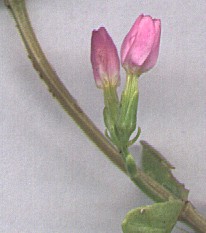Duizendguldenkruid - Centaury - Centaurium minus (Gentianaceae)
(syn. Centaurium umbellatum, Erythraea centaurium)
 |
Duizendguldenkruid staat als "vrij algemeen" in de flora, maar erg vaak ben ik het niet tegengekomen. Deze zomer (2001) trof ik het echter in een vochtige ligweide aan,
en er stond genoeg om één klein plantje mee te nemen. Het valt op door de helderroze bloempjes, die in een vlak scherm naast elkaar staan. Hier zijn er maar twee; de planten
waren ook goeddeels uitgebloeid. Het verbaasde me, de plantjes zo ver van zee aan te treffen, maar het blijkt dat deze variëteit niet van een zout milieu houdt, in tegenstelling
tot de twee andere soorten, Strand- en Fraai duizendguldenkruid (resp. Centaurium littorale en C. pulchellum), die men eerder op de Wadden zal tegenkomen. In the Dutch flora, Centaury is said to be "rather common", but I haven't come across it very often. During the summer of 2001, however, I spotted it in a moist recreation lawn not far from the waterside, a whole lot, so I took one little plant with me. It strikes by its clear-pink flowers, in a more or less flat raceme together. This one has only two; most of the plants were past flowering already. I was surprised, to find these so far from the seaside, but this variety of centaury isn't so fond of saline circumstances, in contrast with the other two indigenous varieties, Beach- and Fine centaury (this I translate from the Dutch names; in latin they are Centaurium littorale and C. pulchellum, respectively), which in the Netherlands you will find mainly on the Frisian islands. |



Boven: Bloemen + knopjes, 4 x vergroot / Above: Flowers + buds, 4 x enlarged


